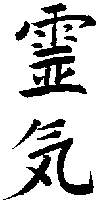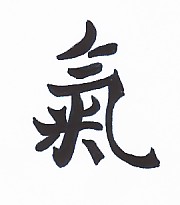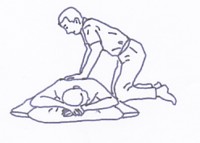REIKI

Reiki is a very gentle but thorough method of hands-on healing in which the practitioner uses specific symbols to focus Universal Energy into any area of the recipient which requires balancing and healing.
Most of you will have heard of it by now, since it is widely publicised in many different forms: there are innumerable websites on the subject giving its history and methodology. I am therefore covering it only briefly here. I personally follow the traditional Usui method.
Reiki can be a way of life as well as a healing method, as the Reiki Principles given below show:
Just for today, do not anger
Just for today, do not worry
Honour your parents, teachers and elders
Earn your living honestly
Show gratitude to every living thing.
Reiki practitioners go through three stages, each of which requires induction by a Reiki Master. The first teaches basic healing techniques; the second gives symbols for mental, physical and distant healing; the third deepens the focus.
Reiki is normally given with the recipient lying down, but can be given sitting, or even standing. Although the hands are traditionally placed on specific areas of the body, it is said and believed that the healing Reiki energy will go to wherever it is most needed. It works on animals (very well, in fact) and can even be used to revive a car engine (honestly!). It can be given in person, or via "absent healing", where the Reiki healer sends healing across a distance, at a specific time. In recent years it has developed many offshoots such as "Kahuna Reiki", "Rainbow Reiki", "Crystal Reiki", depending on the practioner. As with Shiatsu (see below), go to the Reiki practitioner who most suits you.
I am a Reiki Master (having been through all three induction stages) and if anyone would like to receive distant healing, simply email me with your name and somewhere where I can visualise you while working; and I will send you some. Free, though you can make a small donation to a charity of your choice, if you wish! State a time when you would like to
 receive the healing.
receive the healing.
serene@evenstar8.co.uk
SHIATSU
 Shiatsu is a Japanese therapy literally meaning "finger pressure". It stems from Traditional Chinese Medicine (TCM) which is a very detailed set of theories on the workings of the human body dating back some two thousand years.
Shiatsu is a Japanese therapy literally meaning "finger pressure". It stems from Traditional Chinese Medicine (TCM) which is a very detailed set of theories on the workings of the human body dating back some two thousand years.
 A Shiatsu treatment takes place on the floor on a soft mat, with the recipient wearing loose clothing, and uses the same lines of energy (meridians) as acupuncture, but without the use of needles.
A Shiatsu treatment takes place on the floor on a soft mat, with the recipient wearing loose clothing, and uses the same lines of energy (meridians) as acupuncture, but without the use of needles.
TCM is based on maintaining health by keeping the energies of the body in balance, and the practitioner normally begins by using a light touch on the area around the navel (the hara) to diagnose imbalances. By working on the meridians (which traverse the whole body) the practitioner then disperses energy where it is blocked and summons energy to where it is most needed, thus enabling the energy or "Ki" of the client to activate its own natural healing process.
Pressure along the meridians is applied using the practitioner's palms, thumbs, elbows, and sometimes knees and feet. Rotation and stretches to the limbs may also be applied, allowing muscles to release, joint stiffness to ease, and the body structure to realign. Treatment may be as active or as passive as required. In addition to the session, the practitioner may suggest relevant exercises and dietary advice.
Shiatsu can be helpful in a wide range of conditions, particularly any which are chronic. Conditions which receive benefit include digestive disorders, headache, back pain, arthritis, menstrual and menopausal problems, and chronic fatigue syndrome. It has been found to be particularly beneficial in alleviating asthma.
I have personally found regular sessions excellent in maintaining general health and vitality. One word of warning, however: there are several different types of Shiatsu available stemming from varied Japanese "schools", so check out your local practitioners to find one whose methods suit you. Practitioners are normally registered with an association, to ensure that they are fully trained. In my experience, a good practitioner is worth his or her weight in gold - but shouldn't be quite that expensive! And if you have a therapy to offer, many practitioners will work on an exchange.
A link to the International Shiatsu Commision can be found on the Website-Links page.

Back to Issue 5
Just for today, do not worry
Honour your parents, teachers and elders
Earn your living honestly
Show gratitude to every living thing.
Reiki is normally given with the recipient lying down, but can be given sitting, or even standing. Although the hands are traditionally placed on specific areas of the body, it is said and believed that the healing Reiki energy will go to wherever it is most needed. It works on animals (very well, in fact) and can even be used to revive a car engine (honestly!). It can be given in person, or via "absent healing", where the Reiki healer sends healing across a distance, at a specific time. In recent years it has developed many offshoots such as "Kahuna Reiki", "Rainbow Reiki", "Crystal Reiki", depending on the practioner. As with Shiatsu (see below), go to the Reiki practitioner who most suits you.
I am a Reiki Master (having been through all three induction stages) and if anyone would like to receive distant healing, simply email me with your name and somewhere where I can visualise you while working; and I will send you some. Free, though you can make a small donation to a charity of your choice, if you wish! State a time when you would like to
 receive the healing.
receive the healing.
 Shiatsu is a Japanese therapy literally meaning "finger pressure". It stems from Traditional Chinese Medicine (TCM) which is a very detailed set of theories on the workings of the human body dating back some two thousand years.
Shiatsu is a Japanese therapy literally meaning "finger pressure". It stems from Traditional Chinese Medicine (TCM) which is a very detailed set of theories on the workings of the human body dating back some two thousand years.
 A Shiatsu treatment takes place on the floor on a soft mat, with the recipient wearing loose clothing, and uses the same lines of energy (meridians) as acupuncture, but without the use of needles.
A Shiatsu treatment takes place on the floor on a soft mat, with the recipient wearing loose clothing, and uses the same lines of energy (meridians) as acupuncture, but without the use of needles.
TCM is based on maintaining health by keeping the energies of the body in balance, and the practitioner normally begins by using a light touch on the area around the navel (the hara) to diagnose imbalances. By working on the meridians (which traverse the whole body) the practitioner then disperses energy where it is blocked and summons energy to where it is most needed, thus enabling the energy or "Ki" of the client to activate its own natural healing process.
Pressure along the meridians is applied using the practitioner's palms, thumbs, elbows, and sometimes knees and feet. Rotation and stretches to the limbs may also be applied, allowing muscles to release, joint stiffness to ease, and the body structure to realign. Treatment may be as active or as passive as required. In addition to the session, the practitioner may suggest relevant exercises and dietary advice.
Shiatsu can be helpful in a wide range of conditions, particularly any which are chronic. Conditions which receive benefit include digestive disorders, headache, back pain, arthritis, menstrual and menopausal problems, and chronic fatigue syndrome. It has been found to be particularly beneficial in alleviating asthma.
I have personally found regular sessions excellent in maintaining general health and vitality. One word of warning, however: there are several different types of Shiatsu available stemming from varied Japanese "schools", so check out your local practitioners to find one whose methods suit you. Practitioners are normally registered with an association, to ensure that they are fully trained. In my experience, a good practitioner is worth his or her weight in gold - but shouldn't be quite that expensive! And if you have a therapy to offer, many practitioners will work on an exchange.
A link to the International Shiatsu Commision can be found on the Website-Links page.

Back to Issue 5